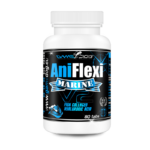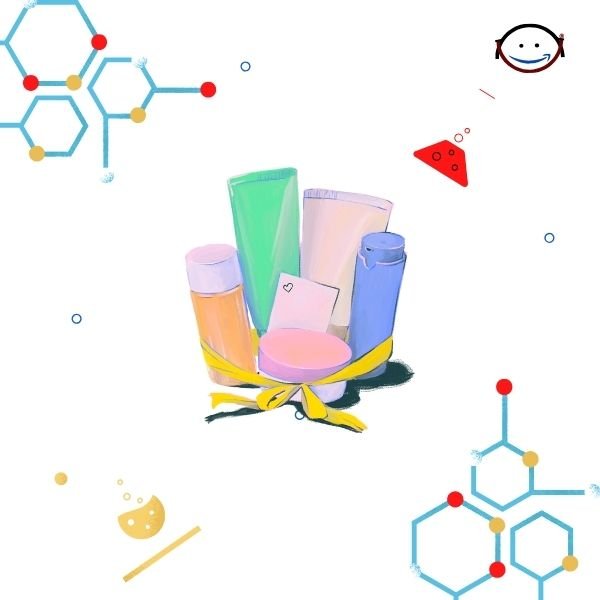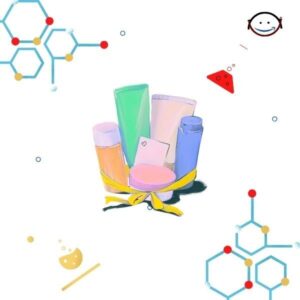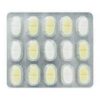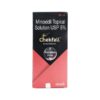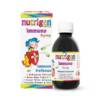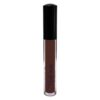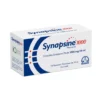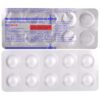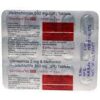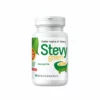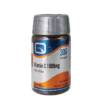-
Double Trouble ₦1,300.00 QTY: 1
-
GLIMY M1 TABLETS 15`S ₦3,645.50 QTY: 2
-
CHEKFALL 5% 60ML TOPICAL SOLUTION ₦16,047.50 QTY: 1
-
Nutrigen Immuno Syrup ₦4,500.00 QTY: 1
-
Kleancolor Madly Matte Lip Gloss – Root Beer ₦1,680.00 QTY: 1
-
Synapsine 1000 10fl 10ml ₦68,476.00 QTY: 2
-
ACIVIR DT 400MG TAB 5`S ₦3,071.25 QTY: 1
-
AZILDAC 40MG TAB 10`S ₦1,985.75 QTY: 1
-
Light Guide Demonstrator ₦1,045.00 QTY: 1
-
Mtfx Tablet 10?S ₦30,600.00 QTY: 1
-
RIFAKEM 550 STRIP OF 10 TABLETS ₦8,229.50 QTY: 1
-
YATO YT-1962 250MM/10″ TIN SNIPS – STRAIGHT CUT ₦11,413.50 QTY: 1
-
GLIMISAVE M2 850MG TAB 15`S ₦3,397.25 QTY: 1
-
Act+Acre Cold Processed Hair Conditioner 296ml ₦70,216.30 QTY: 2
-
DERMADEW VG WASH 100ML LOTION ₦4,326.00 QTY: 1
-
Specchiasol Stevy Green Family Jar 250g ₦17,309.00 QTY: 1
-
Quest Vitamin C 1000mg Timed Release - 60 Pack. ₦10,100.00 QTY: 1
Customer matched zone "Lagos Delivery Options"
“Quest Vitamin C 1000mg Timed Release – 60 Pack.” has been added to your basket. Continue shopping
Sort by:
177–192 of 4627 Results
-
SaleSku: 1736097397-1489
AnsuPen30/70 + 50/50
₦38,500.00Original price was: ₦38,500.00.₦36,575.00Current price is: ₦36,575.00.₦38,500.00Original price was: ₦38,500.00.₦36,575.00Current price is: ₦36,575.00. Add to basket Quick View -
SaleAntiscar 100 mg+50 IU+10 mgThis gel is indicated for the following scar treatment: hypertrophic and keloid scars scar that occurs after surgery scar that occurs after amputation, burns and trauma scar due to traumatic tendon contracture Dosage of Antiscar 100 mg+50 IU+10 mgThis gel should be applied 3-4 times a day to the affected area and massaged gently in order to achieve better penetration. Continue with a circular motion until the gel is completely absorbed. Treatment may take several weeks or months depending on the size of existing scars and contracture.This gel is very safe and its tolerability has been proven in numerous clinical studies. Small children and even babies can be treated safely.Interaction of Antiscar 100 mg+50 IU+10 mgThere is no known and reported drug interaction.ContraindicationsThis gel should not be used in patients with known hypersensitivity to any of its ingredients.Side Effects of Antiscar 100 mg+50 IU+10 mgThis gel is generally well tolerated even in long-term use. In rare cases, some local irritations are reported such as slight erythema and itching. These side effects do not require discontinuation of the treatment.Precautions & WarningsDuring treatment of fresh scars with this preparation, excess cold, UV lights and abrupt massage should be avoided. Avoid contact with eyes, the inside of the nose or mouth and other mucous membranes.Storage ConditionsStore in a cool and dry place, below 25?C. Protect from direct sunlight and moisture. Do not freeze. Keep the medicine out of the reach of children.Mode Of ActionExtract of Allium cepa: It is derived from the membrane of Allium cepa (onion membrane). It shows antiphlogistic efects through inhibition of infammatory mediators? secretion and anti-allergenic efect. Extract of Allium cepa inhibits growth of fbroblast of diferent origin, particularly kelloidal fbroblasts. It has also bactericidal efect. While these properties stimulate primary wound healing, it prevents non-physiological scar formation.Heparin: In case of local application, it shows inhibitory efect on fbroblast proliferation. While heparin increases tissue hydration, it reduces irritation resulted from induration and infammation.Allantoin: Allantoin stimulates cellular proliferation. It also supports the development of healthy cells. Allantoin is convenient substance for the treatment of scar through its properties of stimulating epithelization and providing elastic surface formation.Clinical studies: Evaluation of the use of Extract of Allium cepa, Heparin & Allantoin gel for the prevention of scar formation: Total 1,268 patients were evaluated and after 2 to 3 months of treatment with Extract of Allium cepa, Heparin & Allantoin gel, a reduction of 31.5% in mean scar width and 47.8% reduction of mean scar height at the end of the observation period. Assessment of the use of Extract of Allium cepa, Allantoin, and Heparin in the early treatment of C-section scars: A total of 61 females, aged ?18 years, who had given birth by C-section were evaluated. After six weeks of treatment, the gel showed signifcant improvement of the color, stifness and irregularity of C-section scars. PregnancyThere are no studies conducted during pregnancy and lactation periods. Therefore it should be used with caution.Sku: 1736101396-2679
Antiscar100 mg+50 IU+10 mg
₦16,500.00Original price was: ₦16,500.00.₦14,850.00Current price is: ₦14,850.00.₦16,500.00Original price was: ₦16,500.00.₦14,850.00Current price is: ₦14,850.00. Add to basket Quick View -
SaleAntoris MR 35 mgAntoris MR 35 mg is indicated in adults as add-on therapy for the symptomatic treatment of patients with stable angina pectoris who are inadequately controlled by or intolerant to first-line antianginal therapies.Theropeutic ClassOther Anti-anginal & Anti-ischaemic drugsPharmacologyAntoris MR 35 mg is the first 3- keto acyl CoA thiolase inhibitor (KAT), a metabolic anti-ischemic agent with proven benefits for all coronary patients. Antoris MR 35 mg inhibits fatty acid pathway by inhibiting 3-keto acyl CoA thiolase enzyme and transfers oxygen to glucose pathway. Since glucose pathway is more efficient in producing energy, the same oxygen produces more energy and makes the heart more active. Moreover, the aerobic oxidation of glucose stops production of lactic acid, which prevents angina pectoris.Dosage & Administration of Antoris MR 35 mgThe recommended dose of Trimetazidine is 35 mg twice daily or 20 mg tablet thrice daily during meals. The benefit of the treatment should be assessed after three months and Trimetazidine should be discontinued if there is no treatment response.Dosage of Antoris MR 35 mgThe recommended dose of Trimetazidine is 35 mg twice daily or 20 mg tablet thrice daily during meals. The benefit of the treatment should be assessed after three months and Trimetazidine should be discontinued if there is no treatment response.Interaction of Antoris MR 35 mgNo drug interaction so far has been reported. In particular, no interaction has been reported with beta-blockers, calcium antagonists, nitrates, heparin, hypolipidemic agents or digitalis preparation.ContraindicationsTrimetazidine is contraindicated in patients who have hypersensitivity to the active substance or to any of the excipients. It is also is contraindicated in patients with Parkinson?s disease, parkinsonian symptoms, tremors, restless legs movement disorders, severe renal impairment.Side Effects of Antoris MR 35 mgTrimetazidine is safe and well tolerated. The Common side effects associated with Trimetazidine are dizziness, headache, abdominal pain, diarrhoea, dyspepsia, nausea, vomiting, rash, pruritus, urticaria and astheniaPregnancy & LactationThere is no data on the use of Trimetazidine in pregnant women. Animal studies do not indicate direct or indirect harmful effects with respect to reproductive toxicity. As a precautionary measure, it is preferable to avoid the use of Trimetazidine during pregnancy. It is unknown whether Trimetazidine is excreted in human milk. A risk to the newborns/infants cannot be excluded. Trimetazidine should not be used during breast-feeding.Precautions & WarningsTrimetazidine is not a curative treatment for angina attacks, nor an initial treatment for unstable angina pectoris. It is also not a treatment for myocardial infarction.Storage ConditionsKeep in a dry place away from light and heat. Keep out of the reach of children.Drug ClassesOther Anti-anginal & Anti-ischaemic drugsMode Of ActionAntoris MR 35 mg is the first 3- keto acyl CoA thiolase inhibitor (KAT), a metabolic anti-ischemic agent with proven benefits for all coronary patients. Antoris MR 35 mg inhibits fatty acid pathway by inhibiting 3-keto acyl CoA thiolase enzyme and transfers oxygen to glucose pathway. Since glucose pathway is more efficient in producing energy, the same oxygen produces more energy and makes the heart more active. Moreover, the aerobic oxidation of glucose stops production of lactic acid, which prevents angina pectoris.PregnancyThere is no data on the use of Trimetazidine in pregnant women. Animal studies do not indicate direct or indirect harmful effects with respect to reproductive toxicity. As a precautionary measure, it is preferable to avoid the use of Trimetazidine during pregnancy. It is unknown whether Trimetazidine is excreted in human milk. A risk to the newborns/infants cannot be excluded. Trimetazidine should not be used during breast-feeding.Sku: 1736106110-4050
Antoris MR35 mg
₦8,085.00Original price was: ₦8,085.00.₦7,276.50Current price is: ₦7,276.50.₦8,085.00Original price was: ₦8,085.00.₦7,276.50Current price is: ₦7,276.50. Add to basket Quick View -
SaleAntrenex 5 mgOxyphenonium is indicated in Gastro-intestinal spasm and hypermotility, cardiospasm, esophagospasm, gastroduodenitis, spastic constipation, pylorospasm, peptic ulcer, spasm associated with carcinoma. Pain and spasm of the biliary tract. Pain and spasm of the urinary tract.Theropeutic ClassAnticholinergics (antimuscarinics)/ Anti-spasmodicsPharmacologyOxyphenonium is an anticholinergic drug, a medication that reduces the effect of acetylcholine, a chemical released from nerves that stimulates muscles, by blocking the receptors for acetylcholine on smooth muscle (a type of muscle). It also has a direct relaxing effect on smooth muscle. Oxyphenonium is used to treat or prevent spasm in the muscles of the gastrointestinal tract in the irritable bowel syndrome. In addition, Oxyphenonium inhibits gastrointestinal propulsive motility and decreases gastric acid secretion and controls excessive pharyngeal, tracheal and bronchial secretions.Dosage & Administration of Antrenex 5 mgAverage adult dosage is 10 mg (2 tablets) 4 times daily for several days. Dosage may be reduced depending on patient's response or as directed by the physician.Dosage of Antrenex 5 mgAverage adult dosage is 10 mg (2 tablets) 4 times daily for several days. Dosage may be reduced depending on patient's response or as directed by the physician.Interaction of Antrenex 5 mgReduced gastric motility interferes with absorption of other drugs. Effects potentiated by other antimuscarinics including amantadine, some antihistamines, phenothiazines and TCA.ContraindicationsGlaucoma, obstructive uropathy (for example, bladder neck obstruction due to prospective hypertrophy), obstructive disease of the gastrointestinal tract (as in achalasia, paralytic ileus, pyloroduodenal stenosis, etc.), intestinal atony of the elderly or debilitated patient, unstable cardiovascular status in acute hemorrhage, severe ulcerative colitis, toxic megacolon, complicating ulcerative colitis, myasthenia gravis, hypersensitivity.Side Effects of Antrenex 5 mgCommon side effects are dryness of mouth, headache, palpitations, etc.Pregnancy & LactationEither studies in animals have revealed adverse effects on the foetus (teratogenic or embryocidal or other) and there are no controlled studies in women or studies in women and animals are not available. Drugs should be given only if the potential benefit justifies the potential risk to the foetus.Precautions & WarningsChildren; elderly; benign prostatic hyperplasia; acute MI, cardiac failure, hypertension, thyrotoxicosis; pregnancy and lactation; fever; angle-closure glaucoma.Overdose Effects of Antrenex 5 mgTreatment is the same as for atropine overdosage.Storage ConditionsKeep below 30?C temperature, away from light & moisture. Keep out of the reach of children.Drug ClassesAnticholinergics (antimuscarinics)/ Anti-spasmodicsMode Of ActionOxyphenonium is an anticholinergic drug, a medication that reduces the effect of acetylcholine, a chemical released from nerves that stimulates muscles, by blocking the receptors for acetylcholine on smooth muscle (a type of muscle). It also has a direct relaxing effect on smooth muscle. Oxyphenonium is used to treat or prevent spasm in the muscles of the gastrointestinal tract in the irritable bowel syndrome. In addition, Oxyphenonium inhibits gastrointestinal propulsive motility and decreases gastric acid secretion and controls excessive pharyngeal, tracheal and bronchial secretions.PregnancyEither studies in animals have revealed adverse effects on the foetus (teratogenic or embryocidal or other) and there are no controlled studies in women or studies in women and animals are not available. Drugs should be given only if the potential benefit justifies the potential risk to the foetus.Sku: 1736100593-2432
Antrenex5 mg
₦68.75Original price was: ₦68.75.₦61.60Current price is: ₦61.60. -
SaleAnustat 15 gmThis is indicated for- Internal and external hemorrhoids Post-partum hemorrhoidal condition Anal pruritus, peri-anal eczema, anal fissures and proctitis? Post-hemorrhoidectomy application to relieve pain and discomfort CompositionEach gram ointment contains- Cinchocaine Hydrochloride BP 5 mg Hydrocortisone USP 5 mg Neomycin Sulphate BP equivalent to 10 mg Neomycin Esculin Sesquihydrate equivalent to 10 mg Esculin Each suppository contains- Cinchocaine Hydrochloride BP 5 mg Hydrocortisone USP 5 mg Neomycin Sulphate BP equivalent to 10 mg Neomycin Esculin Sesquihydrate equivalent to 10 mg Esculin Theropeutic ClassCompound steroidal preparations, Drugs used in Ano-rectal regionPharmacologyCinchocaine is a local anesthetic which relieves severe pain and relaxes sphincteric spasm. Hydrocortisone acts as an anti-inflammatory and anti-pruritic agent and thereby eliminates itching and inflammation. Neomycin is a broad-spectrum antibiotic which eradicates most infections which may already be present or arise in lesions of the anorectal area. Esculin improves skin vasculature and is effective in management of cellulitis.Dosage & Administration of Anustat 15 gmOintment: A small quantity of the ointment should be applied with finger in the painful pruritic area in the morning and evening and after each stool. For deep application nozzle should be attached to the tube and inserted to full extent and should be squeezed gently from the lower end while withdrawing.Suppository: One suppository in the morning and one in the evening, and one after each stool.Use in children: Not recommended for children.Dosage of Anustat 15 gmOintment: A small quantity of the ointment should be applied with finger in the painful pruritic area in the morning and evening and after each stool. For deep application nozzle should be attached to the tube and inserted to full extent and should be squeezed gently from the lower end while withdrawing.Suppository: One suppository in the morning and one in the evening, and one after each stool.Use in children: Not recommended for children.ContraindicationsContraindicated in patients hypersensitive to any component of the product.Side Effects of Anustat 15 gmSide effects which have been reported for individual constituents may occur and appropriate precautions should be taken when using this preparation.Pregnancy & LactationUse in pregnancy: The safe use of topical corticosteroids during pregnancy has not been fully established.Precautions & WarningsLike most of the steroids under certain circumstances hydrocortisone may be absorbed in sufficient amount to produce systemic effects. So, long term use should be avoided. Adrenal suppression may occur even without occlusion. When used for prolonged period striae may occur. Skin sensitisation may occur due to Neomycin. Absorption of the antibiotic from wound or inflamed skin may occur and this may affect the hearing irreversibly. Hence this preparation should not be given to extensively damaged skin.Storage ConditionsKeep in a cool dry place protected from light. Keep out of reach of children.Drug ClassesCompound steroidal preparations, Drugs used in Ano-rectal regionMode Of ActionCinchocaine is a local anesthetic which relieves severe pain and relaxes sphincteric spasm. Hydrocortisone acts as an anti-inflammatory and anti-pruritic agent and thereby eliminates itching and inflammation. Neomycin is a broad-spectrum antibiotic which eradicates most infections which may already be present or arise in lesions of the anorectal area. Esculin improves skin vasculature and is effective in management of cellulitis.PregnancyUse in pregnancy: The safe use of topical corticosteroids during pregnancy has not been fully established.Sku: 1736104478-3567
Anustat15 gm
₦4,400.00Original price was: ₦4,400.00.₦3,960.00Current price is: ₦3,960.00.₦4,400.00Original price was: ₦4,400.00.₦3,960.00Current price is: ₦3,960.00. Add to basket Quick View -
SaleAnzet 0.5 mg+10 mgAnzet 0.5 mg+10 mg tablet is indicated in- Anxiety Depression Apathy Psychogenic depression. Depressive neurosses. Masked depression. Psychosomatic affections accompanied by anxiety and apathy. Menopausal depressions. Dysphoria and depression in alcoholics and drug addicts.Theropeutic ClassCombined anxiolytics & anti-depressant drugsPharmacologyMaximum serum concentration is reached in about 4 hours after oral administration of Anzet 0.5 mg+10 mg. The half-life of Flupentixol is about 35 hours and that of Melitracen is about 19 hours. The combination of Flupentixol and Melitracen does not seem to influence the pharmacokinetic properties of the individual compounds. Flupenthixol primarily acts as a neuroleptic drug. The antipsychotic effect of Flupenthixol is achieved by mixed blockade of dopamine D1 and D2 receptors. In the mesolimbic dopamine system of the brain, this accounts for the antipsychotic action of this drug. Flupenthixol has other effects on CNS. In the chemoreceptor trigger zone, the dopamine blockade accounts for the antiemetic effect of the drug.Melitracen is a tricyclic antidepressant. It blocks the neuronal re-uptake of both serotonin and nor-epinephrine in the central nervous system, there by minimizing the symptoms of depression.Dosage & Administration of Anzet 0.5 mg+10 mgAdults: Usually 2 tablets daily, in morning and afternoon. In severe cases, the morning dose may be increased to 2 tablets.Elderly patients: 1 tablet in the morning. Maintenance dose: Usually 1 tablet in the morning or as directed by the physician.Dosage of Anzet 0.5 mg+10 mgAdults: Usually 2 tablets orally daily in the morning and noon. In severe cases, the morning dose may be increased to 2 tablets.Elderly patients: 1 tablet in the morning. Maintenance dose: Usually 1 tablet orally in the morning. In cases of insomnia or severe restlessness, additional treatment with a sedative in the acute phase is recommended.Interaction of Anzet 0.5 mg+10 mgThis tablet may enhance the response to alcohol, barbiturates and other CNS depressants. Simultaneous administration of MAO-inhibitors may cause hypertensive crises. Neuroleptics and thymoleptics reduce the antihypertensive effect of guanethidine and similar acting compounds and thymoleptics enhance the effects of adrenaline and noradrenaline.ContraindicationsThe immediate recovery phase after myocardial infarction. Defects in bundle-branch conduction. Untreated narrow-angle glaucoma. Acute alcohol, barbiturate and opiate intoxications. This tablet should not be given to patients who have received an MAO-inhibitor within two weeks. Not recommended for excitable or overactive patients since its activating effect may lead to exaggeration of these characteristics.Side Effects of Anzet 0.5 mg+10 mgIn the recommended doses side effects are rare. These could be transient restlessness and insomnia.Pregnancy & LactationThe safety of this drug has not been established in pregnancy and lactation.Precautions & WarningsIf previously the patient has been treated with tranquillizers with sedative effect these should be withdrawn gradually.Overdose Effects of Anzet 0.5 mg+10 mgIn cases of overdosage the symptoms of intoxications by melitracen, especially of anticholinergic nature, dominate. More rarely extrapyramidal symptoms due to flupentixol occur. Symptomatic and Supportive. Gastric lavage should be carried out as soon as possible and activated charcoal may be administered. Measures aimed at supporting the respiratory and cardiovascular systems should be instituted. Epinephrine (adrenaline) must not be used for such patients. Convulsions may be treated with diazepam and extrapyramidal symptoms with biperiden.Storage ConditionsStore at a temperature not exceeding 30?C in a dry place. Protect from light. Keep out of reach of children.Drug ClassesCombined anxiolytics & anti-depressant drugsMode Of ActionThis consists of two well known and well proven compounds: flupentixol-a neuroleptic with anxiolytic and antidepressant properties of its own when given in small doses, and melitracen-a bipolar thymoleptic with activating properties in low doses. In combination the compounds render a preparation with antidepressant, anxiolytic and activating properties. Maximal serum concentration is reached in about 4 hours after oral administration of flupentixol and in about 4 hours after oral administration of melitracen. The biological half-life of flupentixol is about 35 hours and that of melitracen is about 19 hours. The combination of Anzet 0.5 mg+10 mg does not seem to influence the pharmacokinetic properties of the individual compounds.PregnancyThis tablet should preferably not be given during pregnancy and lactation.Sku: 1736103546-3298
Anzet0.5 mg+10 mg
₦2,750.00Original price was: ₦2,750.00.₦2,475.00Current price is: ₦2,475.00.₦2,750.00Original price was: ₦2,750.00.₦2,475.00Current price is: ₦2,475.00. Add to basket Quick View -
SaleAnzitor 10 mgAnzitor 10 mg is indicated as an adjunct to diet to reduce elevated total cholesterol, LDL cholesterol, apolipoprotein B (Apo-B) and triglycerides levels in following diseases when response to diet and other non-pharmacological measures is inadequate. To reduce total cholesterol and LDL cholesterol in patients with heterozygous and homozygous familial hypercholesterolaemia. To reduce elevated cholesterol and triglycerides in patient with mixed dyslipidemia (Fredrickson Type Ia and Ib). For the treatment of patients with elevated serum triglyceride levels in hypertriglyceridaemia (Fredrickson Type IV). For the treatment of patients with dysbetalipoproteinaemia (Fredrickson Type III). To reduce cardiac ischaemic events in patients with asymptomatic or mild to moderate symptomatic coronary artery disease with elevated LDL-cholesterol level. To reduce total and LDL-cholesterol concentrations patients with hypercholesterolemia associated with or exacerbated by diabetes mellitus or renal transplantation.Theropeutic ClassOther Anti-anginal & Anti-ischaemic drugs, StatinsPharmacologyAtorvastatin is a selective inhibitor of HMG-CoA reductase. This enzyme is the rate-limiting enzyme responsible for the conversion of HMG-CoA to mevalonate, a precursor of sterols, including cholesterol. Atorvastatin lowers plasma cholesterol and lipoprotein levels by inhibiting HMG-CoA reductase and cholesterol synthesis in the liver and increases the number of hepatic LDL receptors on the cell surface for enhanced uptake and catabolism of LDL.Dosage & Administration of Anzitor 10 mgPrimary hypercholesterolaemia and combined hyperlipidaemia- Adults: Usually 10 mg once daily; if necessary, may be increased at intervals of at least 4 weeks to max. 80 mg once daily. Child (10-18 years): Initially 10 mg once daily, increased if necessary at intervals of at least 4 weeks to usual max. 20 mg once daily. Familial hypercholesterolaemia- Adults: Initially 10 mg daily, increased at intervals of at least 4 weeks to 40 mg once daily; if necessary, further increased to max. 80 mg once daily (or 40 mg once daily combined with anion-exchange resin in heterozygous familial hypercholesterolaemia). Child (10-18 years): Initially 10 mg once daily, increased if necessary at intervals of at least 4 weeks to usual max. 80 mg once daily. Prevention of cardiovascular events- Adults: Initially 10 mg once daily adjusted according to response.Dosage of Anzitor 10 mgPrimary hypercholesterolaemia and combined hyperlipidaemia- Adults: Usually 10 mg once daily; if necessary, may be increased at intervals of at least 4 weeks to max. 80 mg once daily. Child (10-18 years): Initially 10 mg once daily, increased if necessary at intervals of at least 4 weeks to usual max. 20 mg once daily. Familial hypercholesterolaemia- Adults: Initially 10 mg daily, increased at intervals of at least 4 weeks to 40 mg once daily; if necessary, further increased to max. 80 mg once daily (or 40 mg once daily combined with anion-exchange resin in heterozygous familial hypercholesterolaemia). Child (10-18 years): Initially 10 mg once daily, increased if necessary at intervals of at least 4 weeks to usual max. 80 mg once daily. Prevention of cardiovascular events- Adults: Initially 10 mg once daily adjusted according to response.Interaction of Anzitor 10 mgThe risk of myopathy during treatment with Atorvastatin is increased with concurrent administration of cyclosporin, fibric acid derivatives, erythromycin, azole antifungals and niacin. No clinically significant interactions were seen when Atorvastatin was administered with antihypertensives or hypoglycemic agents. Patients should be closely monitored if Atorvastatin is added to digoxin, erythromycin, oral contraceptives, colestipol, antacid and warfarin.ContraindicationsAnzitor 10 mg should not be used in patient with hypersensitivity to any component of this medication. It's contraindicated in active liver disease or unexplained persistent elevations of serum transaminases. It is also contraindicated in patient with history of serious adverse reaction to prior administration of HMG-CoA reductase inhibitors.Side Effects of Anzitor 10 mgAnzitor 10 mg is generally well-tolerated. The most frequent side effects related to Anzitor 10 mg are constipation, flatulence, dyspepsia, abdominal pain. Other side effects includes infection, headache, back pain, rash, asthenia, arthralgia, myalgia.Pregnancy & LactationAnzitor 10 mg is contraindicated in pregnancy and while breast-feeding. Women of child bearing potential should use appropriate contraceptive measures during Atorvastatin therapy. If the woman become pregnant while taking Anzitor 10 mg, it should be discontinued.Precautions & WarningsLiver effects: Liver function tests should be performed before the initiation of treatment and periodically thereafter. Atorvastatin should be used with caution in patients who consume substantial quantities of alcohol or have a history of liver disease. Atorvastatin therapy should be discontinued if markedly elevated CPK levels occur or myopathy is diagnosed or suspected.Overdose Effects of Anzitor 10 mgSpecific treatment is not available for atorvastatin overdose. The patient should be treated symptomatically and supportive measures instituted, as required. Liver function tests should be performed and serum CK levels should be monitored. Due to extensive atorvastatin binding to plasma proteins, hemodialysis is not expected to significantly enhance atorvastatin clearance.Storage ConditionsKeep in a dry place away from light and heat. Keep out of the reach of children.Use In Special PopulationsGeriatric Use: Of the 39,828 patients who received Atorvastatin in clinicalstudies, 15,813 (40%) were ?65 years old and 2,800 (7%) were ?75 years old. No overall differences in safety or effectiveness were observed between these subjects and younger subjects, and other reported clinicalexperience has not identified differences in responses between the elderly and younger patients, but greater sensitivity of some older adults cannot be ruled out. Since advanced age (?65 years) is a predisposing factor for myopathy, Atorvastatin?should be prescribed with caution in the elderly.Hepatic Impairment: Atorvastatin?is contraindicated in patients with active liver disease whichmay include unexplained persistent elevations in hepatic transaminase levelsDrug ClassesOther Anti-anginal & Anti-ischaemic drugs, StatinsMode Of ActionAtorvastatin is a selective inhibitor of HMG-CoA reductase. This enzyme is the rate-limiting enzyme responsible for the conversion of HMG-CoA to mevalonate, a precursor of sterols, including cholesterol. Atorvastatin lowers plasma cholesterol and lipoprotein levels by inhibiting HMG-CoA reductase and cholesterol synthesis in the liver and increases the number of hepatic LDL receptors on the cell surface for enhanced uptake and catabolism of LDL.PregnancyPregnancy: Atorvastatin is contraindicated during pregnancy. Safety in pregnant women has not been established. No controlled clinical trials with atorvastatin have been conducted in pregnant women. Rare reports of congenital anomalies following intrauterine exposure to HMG-CoA reductase inhibitors have been received. Animal studies have shown toxicity to reproduction. Maternal treatment with atorvastatin may reduce the fetal levels of mevalonate which is a precursor of cholesterol biosynthesis. Atorvastatin should not be used in women who are pregnant, trying to become pregnant or suspect they are pregnant. Treatment with atorvastatin should be suspended for the duration of pregnancy or until it has been determined that the woman is not pregnantLactation: It is not known whether atorvastatin or its metabolites are excreted in human milk. In rats, plasma concentrations of atorvastatin and its active metabolites are similar to those in milk. Because of the potential for serious adverse reactions, women taking atorvastatin should not breastfeed their infants. Atorvastatin is contraindicated during breastfeeding.Pediatric UsesHepatic impairment: Anzitor 10 mg should be used with caution in patients with hepatic impairment. Pediatric use: For patients aged 10 years and above, the recommended starting dose of atorvastatin is 10 mg per day with titration up to 20 mg per day. Anzitor 10 mg is not indicated in the treatment of patients below the age of 10 years.Sku: 1736107532-4476
Anzitor10 mg
₦6,600.00Original price was: ₦6,600.00.₦5,940.00Current price is: ₦5,940.00.₦6,600.00Original price was: ₦6,600.00.₦5,940.00Current price is: ₦5,940.00. Add to basket Quick View -
SaleAnzitor 20 mgAnzitor 20 mg is indicated as an adjunct to diet to reduce elevated total cholesterol, LDL cholesterol, apolipoprotein B (Apo-B) and triglycerides levels in following diseases when response to diet and other non-pharmacological measures is inadequate. To reduce total cholesterol and LDL cholesterol in patients with heterozygous and homozygous familial hypercholesterolaemia. To reduce elevated cholesterol and triglycerides in patient with mixed dyslipidemia (Fredrickson Type Ia and Ib). For the treatment of patients with elevated serum triglyceride levels in hypertriglyceridaemia (Fredrickson Type IV). For the treatment of patients with dysbetalipoproteinaemia (Fredrickson Type III). To reduce cardiac ischaemic events in patients with asymptomatic or mild to moderate symptomatic coronary artery disease with elevated LDL-cholesterol level. To reduce total and LDL-cholesterol concentrations patients with hypercholesterolemia associated with or exacerbated by diabetes mellitus or renal transplantation.Theropeutic ClassOther Anti-anginal & Anti-ischaemic drugs, StatinsPharmacologyAtorvastatin is a selective inhibitor of HMG-CoA reductase. This enzyme is the rate-limiting enzyme responsible for the conversion of HMG-CoA to mevalonate, a precursor of sterols, including cholesterol. Atorvastatin lowers plasma cholesterol and lipoprotein levels by inhibiting HMG-CoA reductase and cholesterol synthesis in the liver and increases the number of hepatic LDL receptors on the cell surface for enhanced uptake and catabolism of LDL.Dosage & Administration of Anzitor 20 mgPrimary hypercholesterolaemia and combined hyperlipidaemia- Adults: Usually 10 mg once daily; if necessary, may be increased at intervals of at least 4 weeks to max. 80 mg once daily. Child (10-18 years): Initially 10 mg once daily, increased if necessary at intervals of at least 4 weeks to usual max. 20 mg once daily. Familial hypercholesterolaemia- Adults: Initially 10 mg daily, increased at intervals of at least 4 weeks to 40 mg once daily; if necessary, further increased to max. 80 mg once daily (or 40 mg once daily combined with anion-exchange resin in heterozygous familial hypercholesterolaemia). Child (10-18 years): Initially 10 mg once daily, increased if necessary at intervals of at least 4 weeks to usual max. 80 mg once daily. Prevention of cardiovascular events- Adults: Initially 10 mg once daily adjusted according to response.Dosage of Anzitor 20 mgPrimary hypercholesterolaemia and combined hyperlipidaemia- Adults: Usually 10 mg once daily; if necessary, may be increased at intervals of at least 4 weeks to max. 80 mg once daily. Child (10-18 years): Initially 10 mg once daily, increased if necessary at intervals of at least 4 weeks to usual max. 20 mg once daily. Familial hypercholesterolaemia- Adults: Initially 10 mg daily, increased at intervals of at least 4 weeks to 40 mg once daily; if necessary, further increased to max. 80 mg once daily (or 40 mg once daily combined with anion-exchange resin in heterozygous familial hypercholesterolaemia). Child (10-18 years): Initially 10 mg once daily, increased if necessary at intervals of at least 4 weeks to usual max. 80 mg once daily. Prevention of cardiovascular events- Adults: Initially 10 mg once daily adjusted according to response.Interaction of Anzitor 20 mgThe risk of myopathy during treatment with Atorvastatin is increased with concurrent administration of cyclosporin, fibric acid derivatives, erythromycin, azole antifungals and niacin. No clinically significant interactions were seen when Atorvastatin was administered with antihypertensives or hypoglycemic agents. Patients should be closely monitored if Atorvastatin is added to digoxin, erythromycin, oral contraceptives, colestipol, antacid and warfarin.ContraindicationsAnzitor 20 mg should not be used in patient with hypersensitivity to any component of this medication. It's contraindicated in active liver disease or unexplained persistent elevations of serum transaminases. It is also contraindicated in patient with history of serious adverse reaction to prior administration of HMG-CoA reductase inhibitors.Side Effects of Anzitor 20 mgAnzitor 20 mg is generally well-tolerated. The most frequent side effects related to Anzitor 20 mg are constipation, flatulence, dyspepsia, abdominal pain. Other side effects includes infection, headache, back pain, rash, asthenia, arthralgia, myalgia.Pregnancy & LactationAnzitor 20 mg is contraindicated in pregnancy and while breast-feeding. Women of child bearing potential should use appropriate contraceptive measures during Atorvastatin therapy. If the woman become pregnant while taking Anzitor 20 mg, it should be discontinued.Precautions & WarningsLiver effects: Liver function tests should be performed before the initiation of treatment and periodically thereafter. Atorvastatin should be used with caution in patients who consume substantial quantities of alcohol or have a history of liver disease. Atorvastatin therapy should be discontinued if markedly elevated CPK levels occur or myopathy is diagnosed or suspected.Overdose Effects of Anzitor 20 mgSpecific treatment is not available for atorvastatin overdose. The patient should be treated symptomatically and supportive measures instituted, as required. Liver function tests should be performed and serum CK levels should be monitored. Due to extensive atorvastatin binding to plasma proteins, hemodialysis is not expected to significantly enhance atorvastatin clearance.Storage ConditionsKeep in a dry place away from light and heat. Keep out of the reach of children.Use In Special PopulationsGeriatric Use: Of the 39,828 patients who received Atorvastatin in clinicalstudies, 15,813 (40%) were ?65 years old and 2,800 (7%) were ?75 years old. No overall differences in safety or effectiveness were observed between these subjects and younger subjects, and other reported clinicalexperience has not identified differences in responses between the elderly and younger patients, but greater sensitivity of some older adults cannot be ruled out. Since advanced age (?65 years) is a predisposing factor for myopathy, Atorvastatin?should be prescribed with caution in the elderly.Hepatic Impairment: Atorvastatin?is contraindicated in patients with active liver disease whichmay include unexplained persistent elevations in hepatic transaminase levelsDrug ClassesOther Anti-anginal & Anti-ischaemic drugs, StatinsMode Of ActionAtorvastatin is a selective inhibitor of HMG-CoA reductase. This enzyme is the rate-limiting enzyme responsible for the conversion of HMG-CoA to mevalonate, a precursor of sterols, including cholesterol. Atorvastatin lowers plasma cholesterol and lipoprotein levels by inhibiting HMG-CoA reductase and cholesterol synthesis in the liver and increases the number of hepatic LDL receptors on the cell surface for enhanced uptake and catabolism of LDL.PregnancyPregnancy: Atorvastatin is contraindicated during pregnancy. Safety in pregnant women has not been established. No controlled clinical trials with atorvastatin have been conducted in pregnant women. Rare reports of congenital anomalies following intrauterine exposure to HMG-CoA reductase inhibitors have been received. Animal studies have shown toxicity to reproduction. Maternal treatment with atorvastatin may reduce the fetal levels of mevalonate which is a precursor of cholesterol biosynthesis. Atorvastatin should not be used in women who are pregnant, trying to become pregnant or suspect they are pregnant. Treatment with atorvastatin should be suspended for the duration of pregnancy or until it has been determined that the woman is not pregnantLactation: It is not known whether atorvastatin or its metabolites are excreted in human milk. In rats, plasma concentrations of atorvastatin and its active metabolites are similar to those in milk. Because of the potential for serious adverse reactions, women taking atorvastatin should not breastfeed their infants. Atorvastatin is contraindicated during breastfeeding.Pediatric UsesHepatic impairment: Anzitor 20 mg should be used with caution in patients with hepatic impairment. Pediatric use: For patients aged 10 years and above, the recommended starting dose of atorvastatin is 10 mg per day with titration up to 20 mg per day. Anzitor 20 mg is not indicated in the treatment of patients below the age of 10 years.Sku: 1736105072-3744
Anzitor20 mg
₦11,000.00Original price was: ₦11,000.00.₦9,900.00Current price is: ₦9,900.00.₦11,000.00Original price was: ₦11,000.00.₦9,900.00Current price is: ₦9,900.00. Add to basket Quick View -
SaleAparkin 50 mg+12.5 mgLevodopa & benserazide is indicated for the treatment of all forms of Parkinson's syndrome with the exception of medicine-induced parkinsonism. Levodopa & benserazide dispersible is a formulation which is suitable for patients with dysphagia (difficulties in swallowing) or who require a formulation ... Read moreLevodopa & benserazide is indicated for the treatment of all forms of Parkinson's syndrome with the exception of medicine-induced parkinsonism. Levodopa & benserazide dispersible is a formulation which is suitable for patients with dysphagia (difficulties in swallowing) or who require a formulation with a more rapid onset of action, e.g. patients suffering from early morning and afternoon akinesia, or who exhibit "delayed on" or "wearing off" phenomena. Levodopa & benserazide HBS is indicated for patients presenting with all types of fluctuations in response, especially those related to fluctuations in plasma levels (i.e. "peak dose dyskinesia" and "end of dose deterioration") and for better control of nocturnal symptoms. Further experience is required to determine whether it is also advantageous to use Levodopa & benserazide HBS in new Parkinson patients.Dosage of Aparkin 50 mg+12.5 mgStandard dosage: Treatment with this combination should be introduced gradually; dosage should be assessed individually and titrated for optimal effect. The following dosage instructions should therefore be regarded as guidelines.Initial therapy: In the early stages of Parkinson?s disease, it is advisable to start treatment with one capsule of this combination 62.5 three to four times daily. As soon as tolerability of the initial dosing schedule is confirmed, the dosage should be increased slowly in accordance with the patient?s? response. An optimal effect is generally achieved with a daily dosage of this combination corresponding to 300-800 mg of levodopa 75-200 mg benserazide, to be divided into 3 or more doses. Between 4 and 6 weeks may be needed to achieve the optimal effect. If it proves necessary to further, increase the daily dosage, this should be done on a monthly basis.Maintenance therapy: The average maintenance dosage is 1 capsule of this combination 125 three to six times daily. The number of individual doses (not less than 3) and their distribution throughout the day must be titrated for optimal effect. this combination HBS and this combination dispersible may substitute standard this combination to achieve an optimal effect.Administration of Aparkin 50 mg+12.5 mgWhen taking standard this combination capsules or this combination HBS, patients must always ensure that they swallow the whole capsule without chewing it. this combination dispersible tablets are to be dispersed in a quarter of a glass of water (approx. 25-50 ml). The tablets disintegrate completely, producing a milky-white dispersion within a few minutes. Because of rapid sedimentation, it is advisable to stir the dispersion before drinking. this combination dispersible tablets should be taken within half an hour of preparing the dispersion.Where possible, this combination should be taken at least 30 minutes before or 1 hour after meals, so that the competitive effect of dietary protein on levodopa uptake can be avoided and to facilitate a more rapid onset of action. Undesirable gastrointestinal effects, which may occur mainly in the early stages of the treatment, can largely be controlled by taking this combination with a low protein snack (e.g. biscuits) or liquid or by increasing the dose slowly.ContraindicationsThis combination is contraindicated in: Patients with known hypersensitivity to levodopa or benserazide or any of the excipients. Patients receiving non-selective monoamine oxidase (MAO) inhibitors due to the risk of hypertensive crisis. However, selective MAO-B inhibitors, such as selegiline and rasagiline, or selective MAO-A inhibitors, such as moclobemide, are not contraindicated. Combination of MAO-A and MAO-B inhibitors is equivalent to non-selective MAO inhibition, and hence this combination should not be given concomitantly with this combination. Patients with decompensated endocrine, renal or hepatic function, cardiac disorders, psychiatric diseases with a psychotic component or closed angle glaucoma. Because levodopa may activate a malignant melanoma, this combination should not be used in patients with suspicious, undiagnosed lesions or a history of melanoma. The management of patients with intention tremor and Huntington?s chorea. Patients less than 30 years old (skeletal development must be complete). Storage ConditionsKeep below 30?C temperature, away from light & moisture. Keep out of the reach of children.Drug ClassesAntiparkinson drugsMode Of ActionDopamine, which acts as a neurotransmitter in the brain, is not present in sufficient quantities in the basal ganglia of parkinsonian patients. Levodopa or L-DOPA (3,4-dihydroxy phenylalanine) is an intermediate in dopamine biosynthesis. Levodopa (dopamine precursor) is used as a prodrug to increase dopamine levels since it is able to cross the blood-brain barrier whereas dopamine itself cannot. Once levodopa has entered the central nervous system, it is metabolised to dopamine by aromatic L-amino acid decarboxylase After administration, levodopa is rapidly decarboxylated to dopamine in extracerebral as well as cerebral tissues. As a result, most of the levodopa administered is not available to the basal ganglia, and the dopamine produced peripherally frequently causes unwanted effects. It is therefore particularly desirable to inhibit extracerebral decarboxylation of levodopa. This can be achieved by simultaneous administration of levodopa and benserazide, a peripheral decarboxylase inhibitor. This preparation is a combination of these two substances in a ratio of 4:1- this ratio having proved optimal in clinical trials and therapeutic use- and is just as effective as large doses of levodopa given alone.PregnancyPregnancy Category B3. This combination is contraindicated during pregnancy and in women of childbearing potential in the absence of adequate contraception. If pregnancy occurs in a woman taking this combination, the medicine must be discontinued (as advised by the prescribing physician). The safe use of this combination during lactation has not been established. Since it is not known whether benserazide passes into breast milk, mothers requiring this combination treatment should not nurse their infants, since the occurrence of skeletal malformations in the infants cannot be excluded.Pediatric UsesRenal impairment: Levodopa and benserazide are both extensively metabolised and less than 10% of levodopa is excreted unchanged through the kidneys. No dose reduction is therefore necessary in case of mild or moderate renal insufficiency. Pharmacokinetic data with levodopa in renal impaired patients are not available. This combination is well tolerated by uraemic patients undergoing haemodialysis.Hepatic impairment: Levodopa is mainly metabolised by the aromatic amino acid decarboxylase that is abundantly present in the intestinal tract, in the kidney and heart in addition to the liver. Pharmacokinetic data with levodopa in hepatic impaired patients are not available.Paediatric use: This combination is contraindicated in patients less than 30 years oldSku: 1736099116-1996
Aparkin50 mg+12.5 mg
₦4,400.00Original price was: ₦4,400.00.₦3,960.00Current price is: ₦3,960.00.₦4,400.00Original price was: ₦4,400.00.₦3,960.00Current price is: ₦3,960.00. Add to basket Quick View -
SaleSku: 1736099996-2251
Apelin450 ml
₦16,500.00Original price was: ₦16,500.00.₦14,850.00Current price is: ₦14,850.00.₦16,500.00Original price was: ₦16,500.00.₦14,850.00Current price is: ₦14,850.00. Add to basket Quick View -
SaleApemeg 160 mgMegestrol tablet is indicated for the palliative treatment of advanced carcinoma of the breast or endometrium (i.e., recurrent, inoperable or metastatic disease). It should not be used instead of currently accepted procedures such as surgery, radiation or chemotherapy.Megestrol oral suspension ... Read moreMegestrol tablet is indicated for the palliative treatment of advanced carcinoma of the breast or endometrium (i.e., recurrent, inoperable or metastatic disease). It should not be used instead of currently accepted procedures such as surgery, radiation or chemotherapy.Megestrol oral suspension is indicated for the treatment of anorexia, cachexia, or an unexplained, significant weight loss in patients with a diagnosis of Acquired Immunodeficiency Syndrome (AIDS) & cancer.Theropeutic ClassHormonal ChemotherapyPharmacologyApemeg 160 mg is a synthetic, antineoplastic and progestational drug. While the precise mechanism by which Apemeg 160 mg produces its antineoplastic effects against endometrial carcinoma is unknown at the present time, inhibition of pituitary gonadotrophin production and resultant decrease in estrogen secretion may be factors. The antineoplastic action of Apemeg 160 mg on carcinoma of the breast is effected by modifying the action of other steroid hormones and by exerting a direct cytotoxic effect on tumor cells. In metastatic cancer, hormone receptors may be present in some tissues but not others. The receptor mechanism is a cyclic process whereby estrogen produced by the ovaries enters the target cell, forms a complex with cytoplasmic receptor and is transported into the cell nucleus. There it induces gene transcription and leads to the alteration of normal cell functions. Pharmacologic doses of Apemeg 160 mg not only decrease the number of hormone-dependent human breast cancer cells but also are capable of modifying and abolishing the stimulatory effects of estrogen on these cells.Estimates of plasma levels of Apemeg 160 mg are dependent on the measurement method used. Peak plasma concentrations occur 2 to 3 hours after a single oral dose 160 mg tablets. The plasma half-life of Apemeg 160 mg is 33 to 38 hours. Approximately 66% of an administered dose is excreted in the urine and approximately 20% in the faeces.Dosage & Administration of Apemeg 160 mg Breast cancer: 160 mg/day Endometrial carcinoma: 40-320 mg/day in divided doses. At least 2 months of continuous treatment is considered an adequate period for determining the efficacy of Megestrol. Dosage of Apemeg 160 mgTablet: Breast cancer: 160 mg/day Endometrial carcinoma: 40-320 mg/day in divided doses. At least 2 months of continuous treatment is considered an adequate period for determining the efficacy of Megestrol. Oral Suspension: The recommended adult initial dosage of Megestrol Oral Suspension is 800 mg/day (20 ml/day).Interaction of Apemeg 160 mgWith medicine: Possible interactions of Apemeg 160 mg with concomitant medications have not been investigated.With food and others: Estrogens and Progestogens may cause fluid retention, particularly when given in high dosages or for prolonged periods. Therapy with these agents should be administered cautiously in patients who have preexisting problems with excess fluid.ContraindicationsHistory of hypersensitivity to Apemeg 160 mg or any component of the formulation. Known or suspected pregnancy.Side Effects of Apemeg 160 mgWeight Gain: Weight gain is a frequent side effect of Apemeg 160 mg. This gain has been associated with increased appetite and is not necessarily associated with fluid retention.Thromboembolic Phenomena: Thromboembolic phenomena including thrombophlebitis and pulmonary embolism (in some cases fatal) have been reported.Glucocorticoid Effects: The glucocorticoid activity of Apemeg 160 mg has not been fully evaluated. Clinical cases of new onset diabetes mellitus, exacerbation of preexisting diabetes mellitus, and overt Cushing?s syndrome have been reported in association with the chronic use of Apemeg 160 mg. In addition, clinical cases of adrenal insufficiency have been observed in patients receiving or being withdrawn from chronic Apemeg 160 mg therapy in the stressed and non-stressed state.Other: Nausea, dyspnea, tumor flare, hyperglycemia, glucose intolerance, alopecia, hypertension, carpal tunnel syndrome, mood changes, hot flashes, malaise, asthenia, lethargy, sweating and rash.Pregnancy & LactationPregnancy Category D. The use of progestational agents during the first four months of pregnancy is not recommended. Very small amounts (approximately 0.1%) are excreted in mother's milk. It is however, not known whether these amounts exert any harmful effect on the newborn. Because of the potential for adverse effects on the new born, nursing should be discontinued during treatment with Apemeg 160 mg.Precautions & WarningsGeneral: Close surveillance is indicated for any patient treated for recurrent or metastatic cancer. Use with caution in patients with a history of thromboembolic disease.Use in Diabetics: Exacerbation of preexisting diabetes with increased insulin requirements has been reported in association with the use of Apemeg 160 mg.Overdose Effects of Apemeg 160 mgNo serious unexpected side effects have resulted from studies involving Apemeg 160 mg administered in dosages as high as 1600 mg/day.Storage ConditionsStore in a cool (below 30?C) and dry place, away from light & moisture. Keep all medicines out of reach of children.Use In Special PopulationsPediatric Use: Safety and effectiveness in pediatric patients have not been established.Geriatric Use: In the dose selection for an elderly patient should be cautious, usually starting at the low end of the dosing range, reflecting the greater frequency of decreased hepatic, renal or cardiac function, and of concomitant disease or other drug therapy.Mode Of ActionApemeg 160 mg is a synthetic, antineoplastic and progestational drug. While the precise mechanism by which Apemeg 160 mg produces its antineoplastic effects against endometrial carcinoma is unknown at the present time, inhibition of pituitary gonadotrophin production and resultant decrease in estrogen secretion may be factors. The antineoplastic action of Apemeg 160 mg on carcinoma of the breast is effected by modifying the action of other steroid hormones and by exerting a direct cytotoxic effect on tumor cells. In metastatic cancer, hormone receptors may be present in some tissues but not others. The receptor mechanism is a cyclic process whereby estrogen produced by the ovaries enters the target cell, forms a complex with cytoplasmic receptor and is transported into the cell nucleus. There it induces gene transcription and leads to the alteration of normal cell functions. Pharmacologic doses of Apemeg 160 mg not only decrease the number of hormone-dependent human breast cancer cells but also are capable of modifying and abolishing the stimulatory effects of estrogen on these cells.Estimates of plasma levels of Apemeg 160 mg are dependent on the measurement method used. Peak plasma concentrations occur 2 to 3 hours after a single oral dose 160 mg tablets. The plasma half-life of Apemeg 160 mg is 33 to 38 hours. Approximately 66% of an administered dose is excreted in the urine and approximately 20% in the faeces.PregnancyPregnancy Category D. The use of progestational agents during the first four months of pregnancy is not recommended. Very small amounts (approximately 0.1%) are excreted in mother's milk. It is however, not known whether these amounts exert any harmful effect on the newborn. Because of the potential for adverse effects on the new born, nursing should be discontinued during treatment with Apemeg 160 mg.Pediatric UsesPediatric Use: Safety and effectiveness in pediatric patients have not been established.Geriatric Use: Insufficient data from clinical studies of Apemeg 160 mg tablets are available for patients 65 years of age and older to determine whether they respond differently than younger patients.Sku: 1736096580-1254
Apemeg160 mg
₦4,125.00Original price was: ₦4,125.00.₦3,712.50Current price is: ₦3,712.50.₦4,125.00Original price was: ₦4,125.00.₦3,712.50Current price is: ₦3,712.50. Add to basket Quick View -
SaleApetiz 100 mlMegestrol tablet is indicated for the palliative treatment of advanced carcinoma of the breast or endometrium (i.e., recurrent, inoperable or metastatic disease). It should not be used instead of currently accepted procedures such as surgery, radiation or chemotherapy.Megestrol oral suspension ... Read moreMegestrol tablet is indicated for the palliative treatment of advanced carcinoma of the breast or endometrium (i.e., recurrent, inoperable or metastatic disease). It should not be used instead of currently accepted procedures such as surgery, radiation or chemotherapy.Megestrol oral suspension is indicated for the treatment of anorexia, cachexia, or an unexplained, significant weight loss in patients with a diagnosis of Acquired Immunodeficiency Syndrome (AIDS) & cancer.Theropeutic ClassHormonal ChemotherapyPharmacologyApetiz 100 ml is a synthetic, antineoplastic and progestational drug. While the precise mechanism by which Apetiz 100 ml produces its antineoplastic effects against endometrial carcinoma is unknown at the present time, inhibition of pituitary gonadotrophin production and resultant decrease in estrogen secretion may be factors. The antineoplastic action of Apetiz 100 ml on carcinoma of the breast is effected by modifying the action of other steroid hormones and by exerting a direct cytotoxic effect on tumor cells. In metastatic cancer, hormone receptors may be present in some tissues but not others. The receptor mechanism is a cyclic process whereby estrogen produced by the ovaries enters the target cell, forms a complex with cytoplasmic receptor and is transported into the cell nucleus. There it induces gene transcription and leads to the alteration of normal cell functions. Pharmacologic doses of Apetiz 100 ml not only decrease the number of hormone-dependent human breast cancer cells but also are capable of modifying and abolishing the stimulatory effects of estrogen on these cells.Estimates of plasma levels of Apetiz 100 ml are dependent on the measurement method used. Peak plasma concentrations occur 2 to 3 hours after a single oral dose 160 mg tablets. The plasma half-life of Apetiz 100 ml is 33 to 38 hours. Approximately 66% of an administered dose is excreted in the urine and approximately 20% in the faeces.Dosage & Administration of Apetiz 100 ml Breast cancer: 160 mg/day Endometrial carcinoma: 40-320 mg/day in divided doses. At least 2 months of continuous treatment is considered an adequate period for determining the efficacy of Megestrol. Dosage of Apetiz 100 mlTablet: Breast cancer: 160 mg/day Endometrial carcinoma: 40-320 mg/day in divided doses. At least 2 months of continuous treatment is considered an adequate period for determining the efficacy of Megestrol. Oral Suspension: The recommended adult initial dosage of Megestrol Oral Suspension is 800 mg/day (20 ml/day).Interaction of Apetiz 100 mlWith medicine: Possible interactions of Apetiz 100 ml with concomitant medications have not been investigated.With food and others: Estrogens and Progestogens may cause fluid retention, particularly when given in high dosages or for prolonged periods. Therapy with these agents should be administered cautiously in patients who have preexisting problems with excess fluid.ContraindicationsHistory of hypersensitivity to Apetiz 100 ml or any component of the formulation. Known or suspected pregnancy.Side Effects of Apetiz 100 mlWeight Gain: Weight gain is a frequent side effect of Apetiz 100 ml. This gain has been associated with increased appetite and is not necessarily associated with fluid retention.Thromboembolic Phenomena: Thromboembolic phenomena including thrombophlebitis and pulmonary embolism (in some cases fatal) have been reported.Glucocorticoid Effects: The glucocorticoid activity of Apetiz 100 ml has not been fully evaluated. Clinical cases of new onset diabetes mellitus, exacerbation of preexisting diabetes mellitus, and overt Cushing?s syndrome have been reported in association with the chronic use of Apetiz 100 ml. In addition, clinical cases of adrenal insufficiency have been observed in patients receiving or being withdrawn from chronic Apetiz 100 ml therapy in the stressed and non-stressed state.Other: Nausea, dyspnea, tumor flare, hyperglycemia, glucose intolerance, alopecia, hypertension, carpal tunnel syndrome, mood changes, hot flashes, malaise, asthenia, lethargy, sweating and rash.Pregnancy & LactationPregnancy Category D. The use of progestational agents during the first four months of pregnancy is not recommended. Very small amounts (approximately 0.1%) are excreted in mother's milk. It is however, not known whether these amounts exert any harmful effect on the newborn. Because of the potential for adverse effects on the new born, nursing should be discontinued during treatment with Apetiz 100 ml.Precautions & WarningsGeneral: Close surveillance is indicated for any patient treated for recurrent or metastatic cancer. Use with caution in patients with a history of thromboembolic disease.Use in Diabetics: Exacerbation of preexisting diabetes with increased insulin requirements has been reported in association with the use of Apetiz 100 ml.Overdose Effects of Apetiz 100 mlNo serious unexpected side effects have resulted from studies involving Apetiz 100 ml administered in dosages as high as 1600 mg/day.Storage ConditionsStore in a cool (below 30?C) and dry place, away from light & moisture. Keep all medicines out of reach of children.Use In Special PopulationsPediatric Use: Safety and effectiveness in pediatric patients have not been established.Geriatric Use: In the dose selection for an elderly patient should be cautious, usually starting at the low end of the dosing range, reflecting the greater frequency of decreased hepatic, renal or cardiac function, and of concomitant disease or other drug therapy.Mode Of ActionApetiz 100 ml is a synthetic, antineoplastic and progestational drug. While the precise mechanism by which Apetiz 100 ml produces its antineoplastic effects against endometrial carcinoma is unknown at the present time, inhibition of pituitary gonadotrophin production and resultant decrease in estrogen secretion may be factors. The antineoplastic action of Apetiz 100 ml on carcinoma of the breast is effected by modifying the action of other steroid hormones and by exerting a direct cytotoxic effect on tumor cells. In metastatic cancer, hormone receptors may be present in some tissues but not others. The receptor mechanism is a cyclic process whereby estrogen produced by the ovaries enters the target cell, forms a complex with cytoplasmic receptor and is transported into the cell nucleus. There it induces gene transcription and leads to the alteration of normal cell functions. Pharmacologic doses of Apetiz 100 ml not only decrease the number of hormone-dependent human breast cancer cells but also are capable of modifying and abolishing the stimulatory effects of estrogen on these cells.Estimates of plasma levels of Apetiz 100 ml are dependent on the measurement method used. Peak plasma concentrations occur 2 to 3 hours after a single oral dose 160 mg tablets. The plasma half-life of Apetiz 100 ml is 33 to 38 hours. Approximately 66% of an administered dose is excreted in the urine and approximately 20% in the faeces.PregnancyPregnancy Category D. The use of progestational agents during the first four months of pregnancy is not recommended. Very small amounts (approximately 0.1%) are excreted in mother's milk. It is however, not known whether these amounts exert any harmful effect on the newborn. Because of the potential for adverse effects on the new born, nursing should be discontinued during treatment with Apetiz 100 ml.Pediatric UsesPediatric Use: Safety and effectiveness in pediatric patients have not been established.Geriatric Use: Insufficient data from clinical studies of Apetiz 100 ml tablets are available for patients 65 years of age and older to determine whether they respond differently than younger patients.Sku: 1736103276-3220
Apetiz100 ml
₦27,500.00Original price was: ₦27,500.00.₦25,025.00Current price is: ₦25,025.00.₦27,500.00Original price was: ₦27,500.00.₦25,025.00Current price is: ₦25,025.00. Add to basket Quick View -
SaleApirent 20%Apirent 20% is indicated for the treatment of excessive perspiration of the underarms, hands, feet and scalp.Theropeutic ClassMiscellaneous topical agentsPharmacologyApirent 20% acts locally in the stratum corneum and terminal duct to relieve hyperhidrosis. Aluminium salts cause an obstruction of the ducts of sweat glands at the skin surface. It seems that the metal (Aluminium) ions precipitate with mucopolysaccharides, damaging epithelial cells along with the duct lumen and forms a plug (gel) that blocks sweat output.Dosage & Administration of Apirent 20%Step 1: Apply Apirent 20% topical solution at night after drying the affected areas carefully.Step 2: Wash off in the morning. Do not re-apply the product during the day.Step 3: Initially the product may be applied every night until sweating stops during the day. The frequency of application may be reduced to twice a week or less, if excess sweating is stopped during the day.Dosage of Apirent 20%Step 1: Apply Apirent 20% topical solution at night after drying the affected areas carefully.Step 2: Wash off in the morning. Do not re-apply the product during the day.Step 3: Initially the product may be applied every night until sweating stops during the day. The frequency of application may be reduced to twice a week or less, if excess sweating is stopped during the day.Interaction of Apirent 20%There are no known drug interactions for Apirent 20% topical solution.ContraindicationsApirent 20% is contraindicated in patients with known hypersensitivity to any of its components.Side Effects of Apirent 20%Apirent 20% is normally well tolerated and adverse effects are only mild and short-lasting. But sometimes irritation of the skin like- stinging, burning, redness, swelling, tingling or itching of treated skin areas may occur. These irritations may be alleviated by use of a weak corticosteroid cream.Pregnancy & LactationThere are no restrictions on the use of this medication during pregnancy and lactation.Precautions & WarningsFor external use only. Do not apply this medication to broken, irritated or recently shaved skin. Avoid contact with eyes, mouth, nose and lips. Avoid direct contact with clothing and polished metal or jewellery surfaces. Keep out of reach of children.Storage ConditionsStore in a cool & dry place, protected from light. Keep out of reach of children. Keep away from naked flame. Store upright.Drug ClassesMiscellaneous topical agentsMode Of ActionApirent 20% acts locally in the stratum corneum and terminal duct to relieve hyperhidrosis. Aluminium salts cause an obstruction of the ducts of sweat glands at the skin surface. It seems that the metal (Aluminium) ions precipitate with mucopolysaccharides, damaging epithelial cells along with the duct lumen and forms a plug (gel) that blocks sweat output.PregnancyThere are no restrictions on the use of this medication during pregnancy and lactation.Sku: 1736099400-2077
Apirent20%
₦10,481.90Original price was: ₦10,481.90.₦9,433.60Current price is: ₦9,433.60.₦10,481.90Original price was: ₦10,481.90.₦9,433.60Current price is: ₦9,433.60. Add to basket Quick View -
SaleApit 160 mgMegestrol tablet is indicated for the palliative treatment of advanced carcinoma of the breast or endometrium (i.e., recurrent, inoperable or metastatic disease). It should not be used instead of currently accepted procedures such as surgery, radiation or chemotherapy.Megestrol oral suspension ... Read moreMegestrol tablet is indicated for the palliative treatment of advanced carcinoma of the breast or endometrium (i.e., recurrent, inoperable or metastatic disease). It should not be used instead of currently accepted procedures such as surgery, radiation or chemotherapy.Megestrol oral suspension is indicated for the treatment of anorexia, cachexia, or an unexplained, significant weight loss in patients with a diagnosis of Acquired Immunodeficiency Syndrome (AIDS) & cancer.Theropeutic ClassHormonal ChemotherapyPharmacologyApit 160 mg is a synthetic, antineoplastic and progestational drug. While the precise mechanism by which Apit 160 mg produces its antineoplastic effects against endometrial carcinoma is unknown at the present time, inhibition of pituitary gonadotrophin production and resultant decrease in estrogen secretion may be factors. The antineoplastic action of Apit 160 mg on carcinoma of the breast is effected by modifying the action of other steroid hormones and by exerting a direct cytotoxic effect on tumor cells. In metastatic cancer, hormone receptors may be present in some tissues but not others. The receptor mechanism is a cyclic process whereby estrogen produced by the ovaries enters the target cell, forms a complex with cytoplasmic receptor and is transported into the cell nucleus. There it induces gene transcription and leads to the alteration of normal cell functions. Pharmacologic doses of Apit 160 mg not only decrease the number of hormone-dependent human breast cancer cells but also are capable of modifying and abolishing the stimulatory effects of estrogen on these cells.Estimates of plasma levels of Apit 160 mg are dependent on the measurement method used. Peak plasma concentrations occur 2 to 3 hours after a single oral dose 160 mg tablets. The plasma half-life of Apit 160 mg is 33 to 38 hours. Approximately 66% of an administered dose is excreted in the urine and approximately 20% in the faeces.Dosage & Administration of Apit 160 mg Breast cancer: 160 mg/day Endometrial carcinoma: 40-320 mg/day in divided doses. At least 2 months of continuous treatment is considered an adequate period for determining the efficacy of Megestrol. Dosage of Apit 160 mgTablet: Breast cancer: 160 mg/day Endometrial carcinoma: 40-320 mg/day in divided doses. At least 2 months of continuous treatment is considered an adequate period for determining the efficacy of Megestrol. Oral Suspension: The recommended adult initial dosage of Megestrol Oral Suspension is 800 mg/day (20 ml/day).Interaction of Apit 160 mgWith medicine: Possible interactions of Apit 160 mg with concomitant medications have not been investigated.With food and others: Estrogens and Progestogens may cause fluid retention, particularly when given in high dosages or for prolonged periods. Therapy with these agents should be administered cautiously in patients who have preexisting problems with excess fluid.ContraindicationsHistory of hypersensitivity to Apit 160 mg or any component of the formulation. Known or suspected pregnancy.Side Effects of Apit 160 mgWeight Gain: Weight gain is a frequent side effect of Apit 160 mg. This gain has been associated with increased appetite and is not necessarily associated with fluid retention.Thromboembolic Phenomena: Thromboembolic phenomena including thrombophlebitis and pulmonary embolism (in some cases fatal) have been reported.Glucocorticoid Effects: The glucocorticoid activity of Apit 160 mg has not been fully evaluated. Clinical cases of new onset diabetes mellitus, exacerbation of preexisting diabetes mellitus, and overt Cushing?s syndrome have been reported in association with the chronic use of Apit 160 mg. In addition, clinical cases of adrenal insufficiency have been observed in patients receiving or being withdrawn from chronic Apit 160 mg therapy in the stressed and non-stressed state.Other: Nausea, dyspnea, tumor flare, hyperglycemia, glucose intolerance, alopecia, hypertension, carpal tunnel syndrome, mood changes, hot flashes, malaise, asthenia, lethargy, sweating and rash.Pregnancy & LactationPregnancy Category D. The use of progestational agents during the first four months of pregnancy is not recommended. Very small amounts (approximately 0.1%) are excreted in mother's milk. It is however, not known whether these amounts exert any harmful effect on the newborn. Because of the potential for adverse effects on the new born, nursing should be discontinued during treatment with Apit 160 mg.Precautions & WarningsGeneral: Close surveillance is indicated for any patient treated for recurrent or metastatic cancer. Use with caution in patients with a history of thromboembolic disease.Use in Diabetics: Exacerbation of preexisting diabetes with increased insulin requirements has been reported in association with the use of Apit 160 mg.Overdose Effects of Apit 160 mgNo serious unexpected side effects have resulted from studies involving Apit 160 mg administered in dosages as high as 1600 mg/day.Storage ConditionsStore in a cool (below 30?C) and dry place, away from light & moisture. Keep all medicines out of reach of children.Use In Special PopulationsPediatric Use: Safety and effectiveness in pediatric patients have not been established.Geriatric Use: In the dose selection for an elderly patient should be cautious, usually starting at the low end of the dosing range, reflecting the greater frequency of decreased hepatic, renal or cardiac function, and of concomitant disease or other drug therapy.Mode Of ActionApit 160 mg is a synthetic, antineoplastic and progestational drug. While the precise mechanism by which Apit 160 mg produces its antineoplastic effects against endometrial carcinoma is unknown at the present time, inhibition of pituitary gonadotrophin production and resultant decrease in estrogen secretion may be factors. The antineoplastic action of Apit 160 mg on carcinoma of the breast is effected by modifying the action of other steroid hormones and by exerting a direct cytotoxic effect on tumor cells. In metastatic cancer, hormone receptors may be present in some tissues but not others. The receptor mechanism is a cyclic process whereby estrogen produced by the ovaries enters the target cell, forms a complex with cytoplasmic receptor and is transported into the cell nucleus. There it induces gene transcription and leads to the alteration of normal cell functions. Pharmacologic doses of Apit 160 mg not only decrease the number of hormone-dependent human breast cancer cells but also are capable of modifying and abolishing the stimulatory effects of estrogen on these cells.Estimates of plasma levels of Apit 160 mg are dependent on the measurement method used. Peak plasma concentrations occur 2 to 3 hours after a single oral dose 160 mg tablets. The plasma half-life of Apit 160 mg is 33 to 38 hours. Approximately 66% of an administered dose is excreted in the urine and approximately 20% in the faeces.PregnancyPregnancy Category D. The use of progestational agents during the first four months of pregnancy is not recommended. Very small amounts (approximately 0.1%) are excreted in mother's milk. It is however, not known whether these amounts exert any harmful effect on the newborn. Because of the potential for adverse effects on the new born, nursing should be discontinued during treatment with Apit 160 mg.Pediatric UsesPediatric Use: Safety and effectiveness in pediatric patients have not been established.Geriatric Use: Insufficient data from clinical studies of Apit 160 mg tablets are available for patients 65 years of age and older to determine whether they respond differently than younger patients.Sku: 1736092998-342
Apit160 mg
₦46,750.00Original price was: ₦46,750.00.₦42,075.00Current price is: ₦42,075.00.₦46,750.00Original price was: ₦46,750.00.₦42,075.00Current price is: ₦42,075.00. Add to basket Quick View -
SaleApixan 2.5 mgApixan 2.5 mg is a factor Xa inhibitor indicated: To reduce the risk of stroke and systemic embolism in patients with nonvalvular atrial fibrillation For the prophylaxis of deep vein thrombosis (DVT), which may lead to pulmonary embolism (PE), in patients who have undergone hip or knee replacement surgery ... Read moreApixan 2.5 mg is a factor Xa inhibitor indicated: To reduce the risk of stroke and systemic embolism in patients with nonvalvular atrial fibrillation For the prophylaxis of deep vein thrombosis (DVT), which may lead to pulmonary embolism (PE), in patients who have undergone hip or knee replacement surgery For the treatment of DVT and PE, and for the reduction in the risk of recurrent DVT and PE following initial therapy Theropeutic ClassAnti-coagulants, Anti-platelet drugs, Fibrinolytics (Thrombolytics), Oral Anti-coagulantsPharmacologyApixan 2.5 mg acts by inhibiting coagulation, and thus prevents development of blood clots. As a result of FXa inhibition, Apixan 2.5 mg prolongs clotting tests such as prothrombin time (PT), INR, and activated partial thromboplastin time (aPTT). Changes observed in these clotting tests at the expected therapeutic dose, however, are small, subject to a high degree of variability, and not useful in monitoring the anticoagulation effect of Apixan 2.5 mg.Dosage & Administration of Apixan 2.5 mgReduction of risk of stroke and systemic embolism in nonvalvular atrial fibrillation: The recommended dose: 5 mg orally twice daily.? In patients with at least 2 of the following characteristics: age greater than or equal to 80 years, body weight less than or equal to 60 kg, or serum creatinine greater than or equal to 1.5 mg/dL, the recommended dose is 2.5 mg orally twice daily. Prophylaxis of DVT following hip or knee replacement surgery: The recommended dose is 2.5 mg orally twice daily.Treatment of DVT and PE: The recommended dose is 10 mg taken orally twice daily for 7 days, followed by 5 mg taken orally twice daily.Reduction in the risk of recurrent DVT and PE following initial therapy: The recommended dose is 2.5 mg taken orally twice daily.Dosage of Apixan 2.5 mgRecommended Dose: The recommended dose of Apixan 2.5 mg for most patients is 5 mg taken orally twice daily.Dosage Adjustments: The recommended dose of Apixan 2.5 mg is 2.5 mg twice daily in patients with any 2 of the following characteristics: age ?80 years, body weight ?60 kg, serum creatinine ?1.5mg/dl.CYP3A4 and P-gp inhibitors: When Apixan 2.5 mg is coadministered with drugs that are strong dual inhibitors of cytochrome P450 3A4 (CYP3A4) and P-glycoprotein (P-gp) (e.g. ketoconazole, itraconazole, ritonavir, clarithromycin) the recommended dose is 2.5 mg twice daily.Missed Dose: If a dose of Apixan 2.5 mg is not taken at the scheduled time, the dose should be taken as soon as possible on the same day and twice-daily administration should be resumed. The dose should not be doubled to make up for a missed dose.Discontinuation for Surgery and Other Interventions: Apixan 2.5 mg should be discontinued at least 48 hours prior to elective surgery or invasive procedures with a moderate or high risk of unacceptable or clinically significant bleeding. Apixan 2.5 mg should be discontinued at least 24 hours prior to elective surgery or invasive procedures with a low risk of bleeding or where the bleeding would be non-critical in location and easily controlled.Switching from or to Apixan 2.5 mg: Switching from warfarin to Apixan 2.5 mg: Warfarin should be discontinued and Apixan 2.5 mg started when the international normalized ratio (INR) is below 2.0.Switching from Apixan 2.5 mg to warfarin: Apixan 2.5 mg affects INR, so that INR measurements during co-administration with warfarin may not be useful for determining the appropriate dose of warfarin. If continuous anticoagulation is necessary, discontinue Apixan 2.5 mg and begin both a parenteral anticoagulant and warfarin at the time the next dose of Apixan 2.5 mg would have been taken, discontinuing the parenteral anticoagulant when INR reaches an acceptable range.Switching between Apixan 2.5 mg and anticoagulants other than warfarin: Discontinue one being taken and begin the other at the next scheduled dose.Interaction of Apixan 2.5 mgApixan 2.5 mg is a substrate of both CYP3A4 and P-gp. Inhibitors of CYP3A4 and P-gp increase exposure to Apixan 2.5 mg and increase the risk of bleeding. Inducers of CYP3A4 and P-gp decrease exposure to Apixan 2.5 mg and increase the risk of stroke.ContraindicationsApixan 2.5 mg is contraindicated in patients with the following conditions: Active pathological bleeding. Severe hypersensitivity reaction to Apixan 2.5 mg (i.e. anaphylactic reactions).Side Effects of Apixan 2.5 mgApixan 2.5 mg can cause a skin rash or severe allergic reaction.Pregnancy & LactationPregnancy Category B. There are no adequate and well-controlled studies of Apixan 2.5 mg in pregnant women. Treatment is likely to increase the risk of hemorrhage during pregnancy and delivery. Apixan 2.5 mg should be used during pregnancy only if the potential benefit outweighs the potential risk to the mother and fetus. Treatment of pregnant rats, rabbits, and mice after implantation until the end of gestation resulted in fetal exposure to Apixan 2.5 mg,?but was not associated with increased risk for fetal malformations or toxicity. No maternal or fetal deaths were attributed to bleeding. Increased incidence of maternal bleeding was observed in mice, rats, and rabbits at maternal exposures that were 19, 4, and 1 times, respectively, the human exposure of unbound drug, based on area under plasma-concentration time curve (AUC) comparisons at the maximum recommended human dose (MRHD) of 10 mg (5 mg twice daily).Nursing Mothers: It is unknown whether Apixan 2.5 mg or its metabolites are excreted in human milk. Rats excrete Apixan 2.5 mg in milk (12% of the maternal dose). Women should be instructed either to discontinue breastfeeding or to discontinue Apixan 2.5 mg therapy, taking into account the importance of the drug to the mother.Precautions & WarningsIncreased Risk of Stroke with Discontinuation of Apixan 2.5 mg Discontinuing Apixan 2.5 mg in the absence of adequate alternative anticoagulation increases the risk of thrombotic events. An increased rate of stroke was observed during the transition from Apixan 2.5 mg to warfarin in clinical trials in patients with nonvalvular atrial fibrillation. If Apixan 2.5 mg must be discontinued for a reason other than pathological bleeding, consider coverage with another anticoagulant.Overdose Effects of Apixan 2.5 mgThere is no antidote to Apixan 2.5 mg. Overdose of Apixan 2.5 mg increases the risk of bleeding. Activated charcoal may be useful in the management of Apixan 2.5 mg overdose.Storage ConditionsKeep in a dry place and store below 30?C. Protect from light and keep out of the reach of children.Use In Special PopulationsPediatric Use: Safety and effectiveness in pediatric patients have not been established.Drug ClassesAnti-coagulants, Anti-platelet drugs, Fibrinolytics (Thrombolytics), Oral Anti-coagulantsMode Of ActionApixan 2.5 mg acts by inhibiting coagulation, and thus prevents development of blood clots. As a result of FXa inhibition, Apixan 2.5 mg prolongs clotting tests such as prothrombin time (PT), INR, and activated partial thromboplastin time (aPTT). Changes observed in these clotting tests at the expected therapeutic dose, however, are small, subject to a high degree of variability, and not useful in monitoring the anticoagulation effect of Apixan 2.5 mg.PregnancyPregnancy: There are no adequate and well-controlled studies of Apixan 2.5 mg in pregnant women. Treatment is likely to increase the risk of hemorrhage during pregnancy and delivery. Apixan 2.5 mg should be used during pregnancy only if the potential benefit outweighs the potential risk to the mother and fetus.Labor and Delivery: Safety and effectiveness of Apixan 2.5 mg during labor and delivery have not been studied in clinical trials. Consider the risks of bleeding and of stroke in using Apixan 2.5 mg in this condition.Nursing Mothers: It is unknown whether Apixan 2.5 mg or its metabolites are excreted in human milk. Women should be instructed either to discontinue breastfeeding or to discontinue Apixan 2.5 mg therapy, taking into account the importance of the drug to the mother.Pediatric UsesHepatic Impairment: No dose adjustment is required in patients with mild hepatic impairment. Because patients with moderate hepatic impairment may have intrinsic coagulation abnormalities and there is limited clinical experience with Apixan 2.5 mg in these patients, dosing recommendations cannot be provided Apixan 2.5 mg is not recommended in patients with severe hepatic impairment Renal Impairment: The dosing adjustment for moderate renal impairment is described above. No data inform use in patients with creatinine clearance 69% were 65 and older, and >31% were 75 and older. The effects of Apixan 2.5 mg on the risk of stroke and major bleeding compared to warfarin were maintained in geriatric subjects.Sku: 1736103427-3263
Apixan2.5 mg
₦5,500.00Original price was: ₦5,500.00.₦4,950.00Current price is: ₦4,950.00.₦5,500.00Original price was: ₦5,500.00.₦4,950.00Current price is: ₦4,950.00. Add to basket Quick View -
SaleAprima 10 mgAprima 10 mg is indicated for the treatment of adult patients with active psoriatic arthritis and moderate to severe plaque psoriasis who are candidates for phototherapy or systemic therapy.Theropeutic ClassDisease-modifying antirheumatic drugs (DMARDs)PharmacologyAprima 10 mg is a novel, orally available small molecule inhibitor of type-4 cyclic nucleotide phosphodiesterase (PDE-4). PDE-4 is a cyclic adenosine monophosphate (cAMP)-specific phosphodiesterase that is predominantly located in inflammatory cells. By inhibiting PDE-4, Aprima 10 mg increases intracellular levels of cAMP and thereby inhibits the production of multiple proinflammatory mediators including PDE-4, TNF-alpha, interleukin-2 (IL-2), interferon-gamma, leukotrienes, and nitric oxide synthase. By targeting a central component of the inflammatory signaling cascade rather than a single inflammatory marker, PDE-4 inhibition may restore the homeostatic balance between pro- and anti-inflammatory signalling.Dosage & Administration of Aprima 10 mgThe recommended initial dosage titration of Aprima 10 mg from Day 1 to Day 5 is shown below. Following the 5-day titration, the recommended maintenance dosage is 30 mg twice daily taken orally starting on Day 6. This titration is intended to reduce the gastrointestinal symptoms associated with initial therapy. Aprima 10 mg can be administered without regard to meals.Day 1: 10 mg in morningDay 2: 10 mg in morning and 10 mg in evening Day 3: 10 mg in morning and 20 mg in evening Day 4: 20 mg in morning and 20 mg in evening Day 5: 20 mg in morning and 30 mg in evening Day 6: 30 mg twice dailyDosage adjustment in patients with severe renal impairment.?Aprima 10 mg dosage should be reduced to 30 mg once daily in patients with severe renal impairment. For initial dosage titration, it is recommended that Aprima 10 mg be titrated using only the morning schedule and the evening doses be skipped.Dosage of Aprima 10 mgThe recommended initial dosage titration of Aprima 10 mg from Day 1 to Day 5 is shown below. Following the 5-day titration, the recommended maintenance dosage is 30 mg twice daily taken orally starting on Day 6. This titration is intended to reduce the gastrointestinal symptoms associated with initial therapy. Aprima 10 mg can be administered without regard to meals.Day 1: 10 mg in morningDay 2: 10 mg in morning and 10 mg in evening Day 3: 10 mg in morning and 20 mg in evening Day 4: 20 mg in morning and 20 mg in evening Day 5: 20 mg in morning and 30 mg in evening Day 6: 30 mg twice dailyDosage adjustment in patients with severe renal impairment.?Aprima 10 mg dosage should be reduced to 30 mg once daily in patients with severe renal impairment. For initial dosage titration, it is recommended that Aprima 10 mg be titrated using only the morning schedule and the evening doses be skipped.Interaction of Aprima 10 mgCo-administration of strong cytochrome P450 enzyme inducer Rifampin resulted in a reduction of systemic exposure of Aprima 10 mg.Therefore.the use of cytochrome P450 enzyme inducers (e.g. Rifampin, Phenobarbital,Carbamazepine, Phenytoin) with Aprima 10 mg is not recommended.ContraindicationsAprima 10 mg is contraindicated in patients with a known hypersensitivity to Aprima 10 mg or to any of the excipients in the formulation.Side Effects of Aprima 10 mgThe most frequently occurring side effects of Aprima 10 mg are nausea, diarrhea and headache. Other less frequent side effects are upper respiratory tract infection, vomiting, naospharyngitis, abdominal pain, hypersensitivity, gastroesophageal reflux disease, dyspepsia, fatigue, decrease appetite, cough, rash, insomnia.Pregnancy & LactationPregnancy Category C. It is not known whether Aprima 10 mg or its metabolites are present in human milk; however, Aprima 10 mg was detected in milk of lactating mice. Caution should be exercised when Aprima 10 mg is administered to a nursing woman.Precautions & WarningsTreatment with Aprima 10 mg is associated with an increase in adverse reactions of depression. Patients, their caregivers and families should be advised of the need to be alert for the emergence or worsening of depression, suicidal thoughts or other mood changes and if such changes occur to contact their healthcare provider. Prescribers should carefully evaluate the risks and benefits of continuing treatment with Aprima 10 mg if such events occur.During the controlled period of the studies in psoriatic arthritis, weight decrease between 5-10% of body weight was reported in 10% of subjects treated with Aprima 10 mg 30 mg twice daily compared to 3.3% treated with placebo.Storage ConditionsStore at cool & dry place, protected from light & moisture. Keep the medicine out of the reach of children.Use In Special PopulationsUse in Paediatric patient: The safety and effectiveness of Aprima 10 mg in paediatric patients less than 18 years of age have not been established.Drug ClassesDisease-modifying antirheumatic drugs (DMARDs)Mode Of ActionAprima 10 mg is a novel, orally available small molecule inhibitor of type-4 cyclic nucleotide phosphodiesterase (PDE-4). PDE-4 is a cyclic adenosine monophosphate (cAMP)-specific phosphodiesterase that is predominantly located in inflammatory cells. By inhibiting PDE-4, Aprima 10 mg increases intracellular levels of cAMP and thereby inhibits the production of multiple proinflammatory mediators including PDE-4, TNF-alpha, interleukin-2 (IL-2), interferon-gamma, leukotrienes, and nitric oxide synthase. By targeting a central component of the inflammatory signaling cascade rather than a single inflammatory marker, PDE-4 inhibition may restore the homeostatic balance between pro- and anti-inflammatory signalling.PregnancyPregnancy Category C. It is not known whether Aprima 10 mg or its metabolites are present in human milk; however, Aprima 10 mg was detected in milk of lactating mice. Caution should be exercised when Aprima 10 mg is administered to a nursing woman.Pediatric UsesUse in Paediatric patient: The safety and effectiveness of Aprima 10 mg in paediatric patients less than 18 years of age have not been established.Sku: 1736105941-4000
Aprima10 mg
₦13,750.00Original price was: ₦13,750.00.₦12,375.00Current price is: ₦12,375.00.₦13,750.00Original price was: ₦13,750.00.₦12,375.00Current price is: ₦12,375.00. Add to basket Quick View
